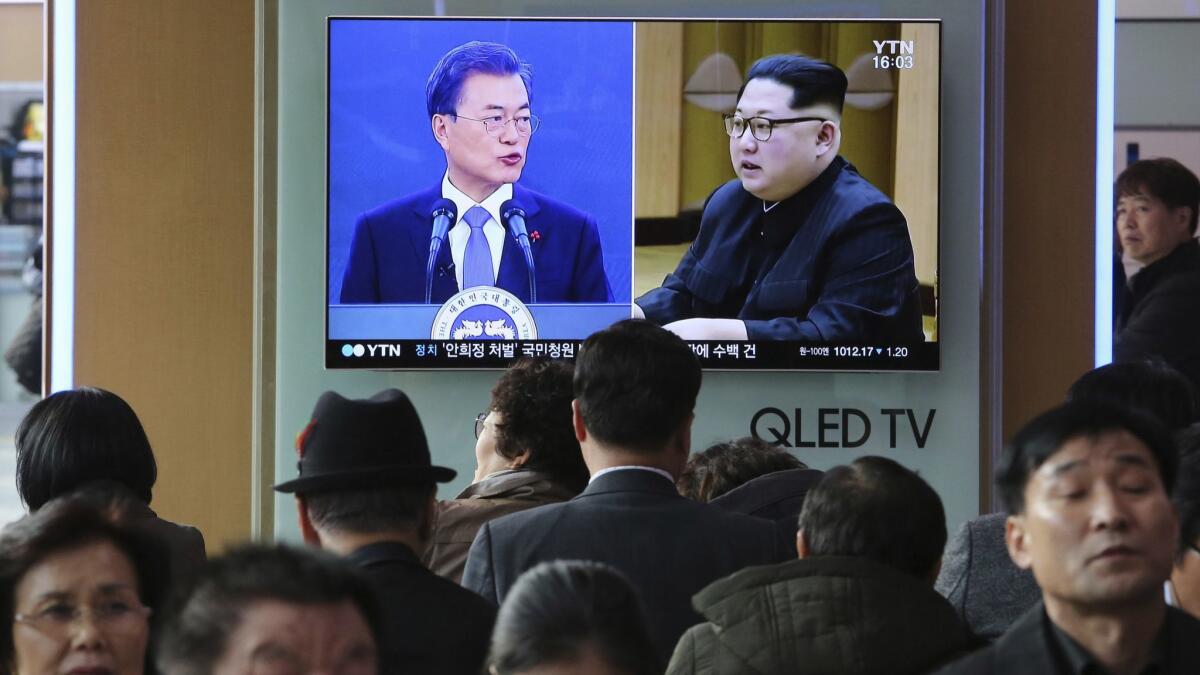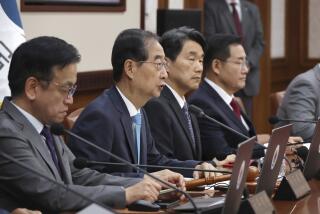The two Koreas agree to talk again — and a Kim-Trump summit remains possible

- Share via
Reporting from SEOUL — Momentum continues to build toward a historic security summit between the leaders of North and South Korea, talks that might also pave the way for Kim Jong Un to meet President Trump in May.
Negotiators for the North and South agreed Saturday on a plan to meet again Thursday inside the demilitarized zone — a buffer area separating the two countries — to continue refining the agenda for next month’s historic, top-level summit between their respective leaders.
The announcement from the South Korean Unification Ministry said the talks would be held at Tongilgak, a building on the North Korean side of Panmunjom, an iconic diplomatic outpost along the highly fortified border between the two countries.
The outpost is where negotiators from the two countries discussed their joint participation in the recent Winter Olympics — a diplomatic breakthrough that has revived hopes that years of inter-Korean tension might be easing.
The Olympics diplomacy also led to the prospect that Trump might attend a summit in May with Kim, the North Korean leader who made the offer in early March to a delegation from the South that was visiting the North’s capital, Pyongyang. The pair could also agree to meet at Panmunjom, because of its proximity to the North and security.
The likelihood of any Kim-Trump summit remains unknown, as does the agenda, and the North hasn’t publicly acknowledged its invitation. But some preliminary talks appear to have occurred in recent days as North Korean diplomats traveled to Finland and Sweden. The latter is an occasional intermediary for matters involving the North and the United States.
Both potential summits hold out hope that North Korea might be willing to discuss its advancing nuclear weapons and ballistic missile programs, which have prompted international condemnation and further isolated the totalitarian nation through economic sanctions.
President Moon Jae-in of South Korea this week said that Pyongyang and Seoul must seek better relations on the peninsula, but that Kim’s nation must also try to find agreement with its longtime adversary, the United States, which has 28,000 troops based around the South.
“Settlement of peace on the Korean peninsula cannot be achieved solely by agreements between the two Koreas,” he said. “It needs to be guaranteed by the U.S. And that requires a normalized relationship between the U.S. and North Korea, which must further advance to economic cooperation between the two countries.”
The North, which test-launched three intercontinental ballistic missiles last year and detonated a hydrogen bomb underground, claims it can attack the U.S. mainland with a nuclear strike. Kim and Trump traded insults and threats during 2017, making prospects for a face-to-face meeting all the more surprising.
Next week’s meeting between the North and South, described as “high-level” talks between top ministerial aides, is to hammer out the details for next month’s summit between Kim and Moon.
The respective ministers handling inter-Korean affairs — the same men who negotiated the Olympics deal — were expected to lead the talks.
If a Moon-Kim summit occurs, probably in late April, it would be only the third face-to-face meeting between the leaders of the two countries — and the first since 2007. They remain divided under a 1953 armistice that ended Korean War hostilities.
In a statement Saturday, the South’s Unification Ministry said it “will put its utmost efforts in preparing for the inter-Korean summit through the high-level talks.”
Stiles is a special correspondent.
More to Read
Sign up for Essential California
The most important California stories and recommendations in your inbox every morning.
You may occasionally receive promotional content from the Los Angeles Times.











